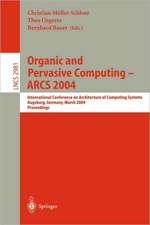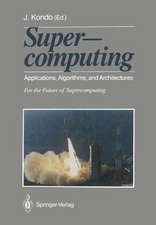Processor Architecture: From Dataflow to Superscalar and Beyond
Autor Jurij Silc, Borut Robic, Theo Ungereren Limba Engleză Paperback – 8 iun 1999
Preț: 619.91 lei
Preț vechi: 774.89 lei
-20% Nou
Puncte Express: 930
Preț estimativ în valută:
118.62€ • 123.85$ • 98.17£
118.62€ • 123.85$ • 98.17£
Carte tipărită la comandă
Livrare economică 04-18 aprilie
Preluare comenzi: 021 569.72.76
Specificații
ISBN-13: 9783540647980
ISBN-10: 3540647988
Pagini: 416
Ilustrații: XXII, 389 p. 14 illus.
Dimensiuni: 155 x 235 x 22 mm
Greutate: 1.28 kg
Ediția:Softcover reprint of the original 1st ed. 1999
Editura: Springer Berlin, Heidelberg
Colecția Springer
Locul publicării:Berlin, Heidelberg, Germany
ISBN-10: 3540647988
Pagini: 416
Ilustrații: XXII, 389 p. 14 illus.
Dimensiuni: 155 x 235 x 22 mm
Greutate: 1.28 kg
Ediția:Softcover reprint of the original 1st ed. 1999
Editura: Springer Berlin, Heidelberg
Colecția Springer
Locul publicării:Berlin, Heidelberg, Germany
Public țintă
Professional/practitionerCuprins
1. Basic Pipelining and Simple RISC Processors.- 1.1 The RISC Movement in Processor Architecture.- 1.2 Instruction Set Architecture.- 1.3 Examples of RISC ISAs.- 1.4 Basic Structure of a RISC Processor and Basic Cache MMU Organization.- 1.5 Basic Pipeline Stages.- 1.6 Pipeline Hazards and Solutions.- 1.7 RISC Processors.- 1.8 Lessons learned from RISC.- 2. Dataflow Processors.- 2.1 Dataflow Versus Control-Flow.- 2.2 Pure Dataflow.- 2.3 Augmenting Dataflow with Control-Flow.- 2.4 Lessons learned from Dataflow.- 3. CISC Processors.- 3.1 A Brief Look at CISC Processors.- 3.2 Out-of-Order Execution.- 3.3 Dynamic Scheduling.- 3.4 Some CISC Microprocessors.- 3.5 Conclusions.- 4. Multiple-Issue Processors.- 4.1 Overview of Multiple-Issue Processors.- 4.2 I-Cache Access and Instruction Fetch.- 4.3 Dynamic Branch Prediction and Control Speculation.- 4.4 Decode.- 4.5 Rename.- 4.6 Issue and Dispatch.- 4.7 Execution Stages.- 4.8 Finalizing Pipelined Execution.- 4.9 State-of-the-Art Superscalar Processors.- 4.10 VLIW and EPIC Processors.- 4.11 Conclusions on Multiple-Issue Processors.- 5. Future Processors to use Fine-Grain Parallelism.- 5.1 Trends and Principles in the Giga Chip Era.- 5.2 Advanced Superscalar Processors.- 5.3 Superspeculative Processors.- 5.4 Multiscalar Processors.- 5.5 Trace Processors.- 5.6 DataScalar Processors.- 5.7 Conclusions.- 6. Future Processors to use Coarse-Grain Parallelism.- 6.1 Utilization of more Coarse-Grain Parallelism.- 6.2 Chip Multiprocessors.- 6.3 Multithreaded Processors.- 6.4 Simultaneous Multithreading.- 6.5 Simultaneous Multithreading versus Chip Multiprocessor.- 6.6 Conclusions.- 7. Processor-in-Memory, Reconfigurable, and Asynchronous Processors.- 7.1 Processor-in-Memory.- 7.2 Reconfigurable Computing.- 7.3 Asynchronous Processors.- 7.4Conclusions.- Acronyms.- References.
Textul de pe ultima copertă
This monograph surveys architectural mechanisms and implementation techniques for exploiting fine-grained and coarse-grained parallelism within microprocessors. It starts with a review of past techniques, continues with a comprehensive account of state-of-the-art techniques used in microprocessors that covers both the concepts involved and implementations in sample processors, and ends with a thorough review of the research techniques that will lead to future microprocessors.
Caracteristici
The book describes all processor architecture technologies The authors also provide application-oriented methods for the development of new processors Includes supplementary material: sn.pub/extras

























